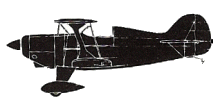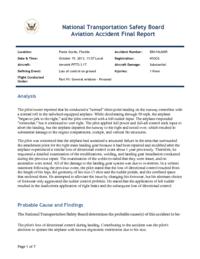
ASN Wikibase Occurrence # 289673
This information is added by users of ASN. Neither ASN nor the Flight Safety Foundation are responsible for the completeness or correctness of this information.
If you feel this information is incomplete or incorrect, you can submit corrected information.
| Date: | Saturday 19 October 2013 |
| Time: | 10:57 LT |
| Type: |  Pitts S-1T |
| Owner/operator: | |
| Registration: | N53CG |
| MSN: | 1007 |
| Year of manufacture: | 1982 |
| Total airframe hrs: | 1050 hours |
| Engine model: | Lycoming IO-360A1F6 |
| Fatalities: | Fatalities: 0 / Occupants: 1 |
| Aircraft damage: | Substantial |
| Category: | Accident |
| Location: | Punta Gorda, Florida -
 United States of America United States of America
|
| Phase: | Landing |
| Nature: | Private |
| Departure airport: | Punta Gorda-Charlotte County Airport, FL (PGD/KPGD) |
| Punta Gorda-Charlotte County Airport, FL (PGD/KPGD) | |
| Investigating agency: | NTSB |
| Confidence Rating: |
The pilot/owner reported that he conducted a "normal" three-point landing on the runway centerline with a normal roll in the tailwheel-equipped airplane. While decelerating through 50 mph, the airplane "began to jerk to the right," and the pilot corrected with a left rudder input. The airplane responded "somewhat," but it continued to veer right. The pilot applied full power and full-aft control stick input to abort the landing, but the airplane departed the runway to the right and nosed over, which resulted in substantial damage to the engine compartment, cockpit, and vertical fin structures.
The pilot was concerned that the airplane had sustained a structural failure in the area that surrounded the attachment point for the right main landing gear because it had been repaired and modified after the airplane experienced a similar loss of directional control event about 1 year previously. Therefore, he requested a detailed examination of the modifications, welding, and landing gear installation conducted during the previous repair. The examination of the welds revealed that they were intact, and no anomalies were noted. All of the damage to the landing gear system was due to overstress. In a written statement following the previous event, the pilot stated that the loss of directional control resulted from the length of his legs, the geometry of his size-13 shoe and the rudder pedals, and the confined space that enclosed them. He attempted to alleviate the issue by changing his footwear, but his alternate choice of footwear only aggravated the rudder control problem. He stated that the application of left rudder resulted in the inadvertent application of right brake and the subsequent loss of directional control.
Probable Cause: The pilot's loss of directional control during landing. Contributing to the accident was the pilot's decision to operate the airplane with known ergonomic restrictions due to his size.
Accident investigation:
 |
|
Sources:
NTSB ERA14LA005
Location
Revision history:
| Date/time | Contributor | Updates |
|---|---|---|
| 05-Oct-2022 16:55 | ASN Update Bot | Added |
Corrections or additions? ... Edit this accident description
The Aviation Safety Network is an exclusive service provided by:


 ©2024 Flight Safety Foundation
©2024 Flight Safety Foundation